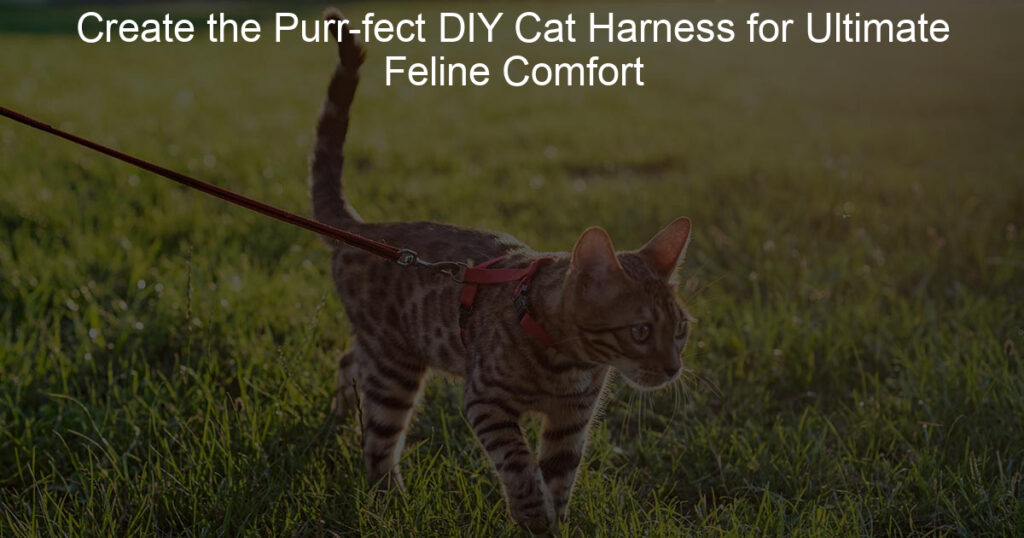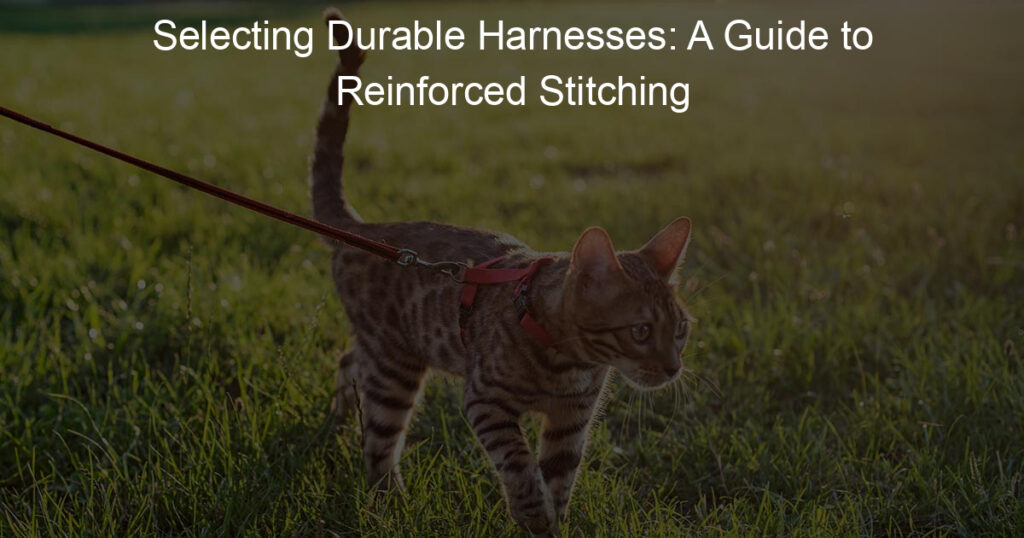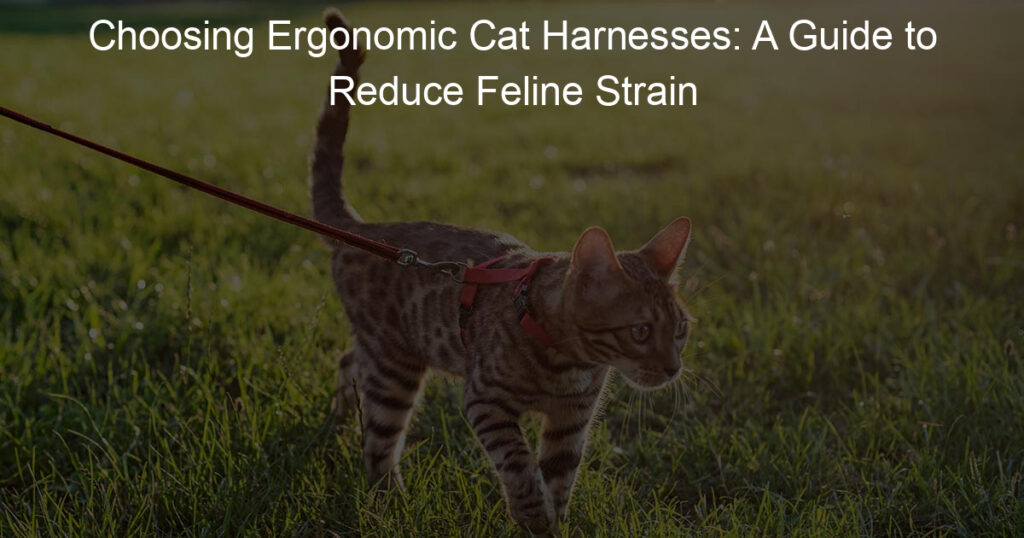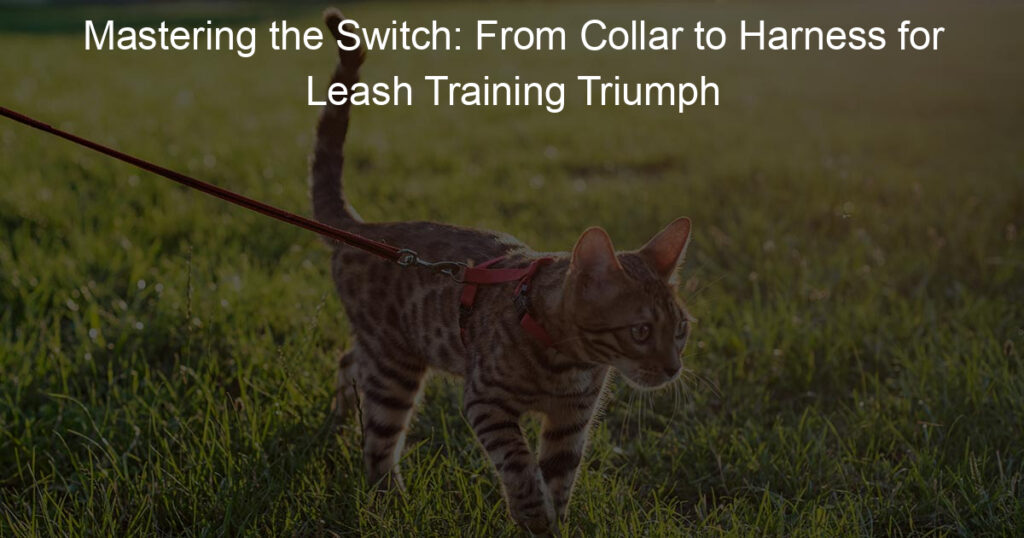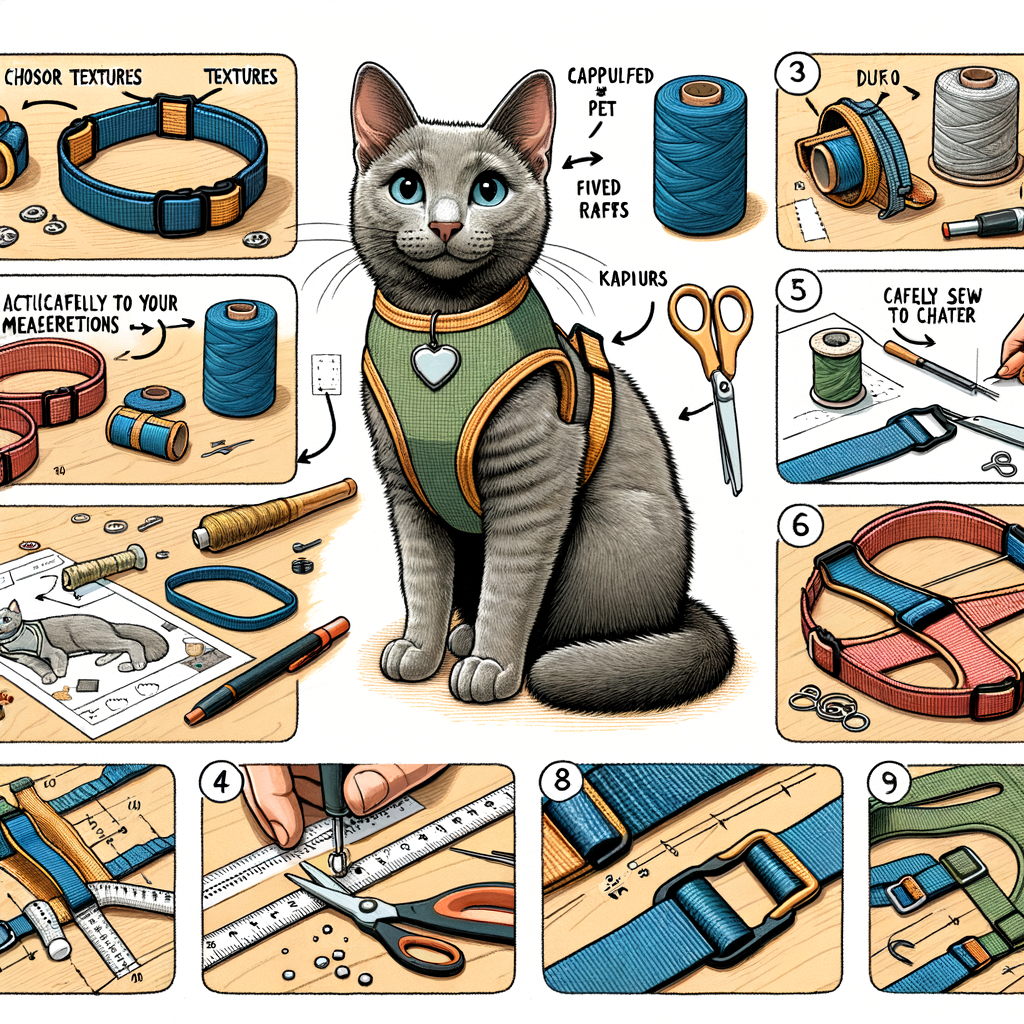
Introduction to DIY Cat Harness
Have you ever thought about making a cat harness for your feline friend? It’s easier than you might think! In this blog post, we will introduce you to the world of DIY cat harnesses. We will discuss why you might want to consider making your own cat harness and the benefits of a customized cat harness. Let’s dive in!
- Why a DIY Cat Harness?
- Benefits of a Customized Cat Harness
There are several reasons why you might want to consider making a DIY cat harness. First, it can be a fun and rewarding project. You get to use your creativity and craft skills to create something unique and special for your cat. Second, it can be more cost-effective than buying a store-bought harness. You can often make a DIY cat harness for a fraction of the cost of a store-bought one. Lastly, a DIY cat harness allows you to customize the harness to fit your cat perfectly. This can make it more comfortable for your cat and can help prevent them from escaping from the harness.
A customized cat harness has several benefits. First, it can provide a better fit for your cat. Every cat is unique, and a one-size-fits-all harness might not fit your cat perfectly. A customized cat harness allows you to adjust the size and shape to fit your cat’s body perfectly. This can make the harness more comfortable for your cat and can help prevent them from escaping. Second, a customized cat harness allows you to choose the materials and colors that you like. You can create a harness that matches your cat’s personality and style. Lastly, a customized cat harness can be a great way to show off your craft skills. It’s a unique and personal item that you can be proud of.
Materials Needed for Crafting Cat Harness
Creating a cat harness at home is not only cost-effective but also allows you to customize it to your cat’s comfort. Let’s take a look at the materials and tools you will need for this DIY project.
- Material Selection for Optimal Comfort
Choosing the right material is crucial for your cat’s comfort. Here are some materials you can consider:
- Nylon Webbing: This is a durable and lightweight material. It’s perfect for a cat harness as it won’t weigh down your cat.
- Soft Cotton: Cotton is soft and breathable, making it comfortable for your cat to wear. However, it may not be as durable as nylon.
- Padded Mesh: If you want to provide extra comfort for your cat, consider using padded mesh. It’s soft and breathable, and the padding provides additional cushioning.
Remember, the material you choose should be both comfortable and durable. It should also be easy to clean, as cat harnesses can get dirty quickly.
- Tools Required for Homemade Cat Harness
Once you’ve chosen your material, you’ll need some tools to put your cat harness together. Here’s what you’ll need:
- Sewing Machine: A sewing machine will make the process faster and easier. However, if you don’t have one, you can also sew by hand.
- Thread: Choose a thread that matches the color of your material. Make sure it’s strong enough to hold the harness together.
- Scissors: You’ll need a good pair of scissors to cut your material and thread.
- Measuring Tape: A measuring tape is essential to ensure your harness fits your cat perfectly.
- Buckles and D-Rings: You’ll need some buckles to secure the harness on your cat and D-rings to attach a leash.
With these materials and tools, you’re now ready to start crafting your homemade cat harness. In the next section, we’ll guide you through the step-by-step process.
Step-by-Step Cat Harness Tutorial
Creating a cat harness at home can be a fun and rewarding project. In this section, we will guide you through the first step of the process: measuring your cat. This is a crucial step to ensure the harness fits comfortably and securely.
Step 1: Measuring Your Cat
Before you start crafting your cat harness, it’s essential to take accurate measurements of your cat. This will ensure the harness fits well and doesn’t cause any discomfort to your feline friend.
- How to Properly Measure Your Cat for a Harness
- Ensuring Comfort and Fit
Start by measuring around your cat’s neck using a soft measuring tape. Be sure not to pull the tape too tight; you should be able to fit two fingers comfortably between the tape and your cat’s neck. Next, measure around the widest part of your cat’s chest, again ensuring the tape is not too tight. Write down these measurements as they will guide you in cutting your material.
Remember, the key to a successful cat harness is comfort. The harness should be snug, but not too tight. If it’s too loose, your cat might slip out of it; if it’s too tight, it could cause discomfort or even injury. Always double-check your measurements and adjust as necessary. It’s better to err on the side of the harness being a bit too loose rather than too tight.
Now that you have your cat’s measurements, you’re ready to move on to the next step: cutting the material. But remember, patience and precision are key in this process. Happy crafting!
Step 2: Cutting the Material
Once you have your measurements, it’s time to cut the material for your cat’s harness. This step is crucial as it determines the comfort and fit of the harness. Let’s dive into the process.
- How to Cut Material for Optimal Comfort Cat Harness
- Precautions to Take While Cutting
First, lay out your chosen material on a flat surface. Using a fabric marker, draw out the shape of the harness based on the measurements you took earlier. Remember to add an extra inch for seams. Then, using a pair of sharp fabric scissors, carefully cut out the shape. It’s important to make smooth, even cuts to ensure the comfort of your cat.
When cutting the material, safety is paramount. Always cut away from your body and keep your fingers clear of the cutting line. Ensure your scissors are sharp enough to avoid jagged edges. If you’re using a material that frays, consider using pinking shears to reduce fraying. Remember, a well-cut material will result in a more comfortable and durable harness for your feline friend.
With the material cut, you’re one step closer to creating a comfortable and custom-fit harness for your cat. In the next step, we’ll delve into sewing the harness together. Stay tuned!
Step 3: Sewing the Harness
Now that you’ve measured your cat and cut the material, it’s time to sew the harness. This step is crucial as it ensures the durability and comfort of the harness. Let’s dive into the stitching techniques and how to ensure the harness is both durable and comfortable for your pet.
- Stitching Techniques for DIY Pet Accessories
When sewing a cat harness, it’s important to use a strong and durable stitch. The most recommended stitch for DIY pet accessories is the ‘Backstitch’. This stitch is known for its strength and durability, making it perfect for a cat harness that needs to withstand the antics of your playful feline.
Here’s how you can do a backstitch:
- Thread your needle and tie a knot at the end of the thread.
- Push the needle up through the fabric from the back to the front.
- Insert the needle back into the fabric a short distance from where it came out.
- Bring the needle back up a short distance from where it went in.
- Repeat this process until you’ve sewn the entire length of the material.
- Ensuring Durability and Comfort
To ensure the durability of your cat harness, make sure to double stitch the areas where the straps intersect. This will provide extra strength and prevent the harness from coming apart.
For comfort, use a soft fabric like cotton or fleece for the inner layer of the harness. This will prevent any chafing against your cat’s skin. Also, ensure the harness is not too tight. You should be able to fit two fingers between the harness and your cat’s body.
Remember, a comfortable cat is a happy cat. And a durable harness means less worry for you and more fun adventures for your feline friend.
Keep these tips in mind as you sew your DIY cat harness. In the next step, we’ll discuss how to fit the harness on your cat safely and comfortably.
Step 4: Fitting the Harness on Your Cat
Now that you’ve successfully created your DIY cat harness, it’s time to fit it on your feline friend. This step is crucial to ensure the comfort and safety of your cat. Let’s explore how to do this effectively.
- How to Safely Fit the Harness
- Adjusting the Harness for Comfort
Firstly, approach your cat calmly and gently to avoid any stress or fear. Start by slipping the harness over your cat’s head, ensuring that the larger loop is at the bottom. Next, bring the smaller loop around your cat’s waist and secure it. Remember, the harness should be snug but not tight. You should be able to fit two fingers between the harness and your cat’s body.
Adjusting the harness is key to your cat’s comfort. If the harness is too tight, it can cause discomfort and restrict movement. If it’s too loose, your cat might escape. To adjust, simply slide the adjuster on the harness until you achieve the desired fit. Always check the fit by trying to slide two fingers between the harness and your cat’s body. If you can do this comfortably, then the harness is well adjusted.
Remember, patience is key when fitting the harness. Your cat might not be used to wearing a harness, so take your time and make the experience positive. Reward your cat with treats and praise to make the harness fitting process a positive experience.
| Key Points |
|---|
| Approach your cat calmly and gently |
| Ensure the harness is snug but not tight |
| Adjust the harness for optimal comfort |
| Make the experience positive with treats and praise |
Additional Tips for Making Cat Harness at Home
Creating a cat harness at home can be a fun and rewarding project. However, to ensure the best results, it’s important to consider a few additional tips. These include choosing the right material, ensuring the harness is secure, and maintaining the harness properly.
- Choosing the Right Material
- Ensuring the Harness is Secure
- Maintaining the Harness
When making a cat harness, the material you choose is crucial. It should be durable enough to withstand your cat’s movements, but also comfortable for your pet to wear. Nylon and cotton are popular choices because they are strong, lightweight, and easy to clean. Avoid materials that can easily fray or tear, as they may not be safe for your cat.
Security is another important factor to consider when making a cat harness. It should fit snugly, but not too tightly, around your cat’s body. A loose harness can allow your cat to escape, while a too-tight harness can cause discomfort or even injury. To ensure a good fit, measure your cat’s body carefully before you start making the harness. Remember, it’s always better to err on the side of caution and make the harness a little larger, as you can always adjust it later.
Maintenance is key to ensuring your homemade cat harness lasts. Regularly check the harness for any signs of wear and tear, and repair or replace it as necessary. Cleaning the harness regularly can also help to extend its lifespan. Most materials can be hand-washed with mild soap and warm water, then air-dried. Always check the harness thoroughly after cleaning to ensure it’s completely dry before putting it back on your cat.
In conclusion, making a cat harness at home can be a rewarding project, but it’s important to choose the right materials, ensure the harness is secure, and maintain it properly. With these tips in mind, you can create a safe and comfortable harness for your feline friend.
Conclusion: Enjoying Your Comfortable Cat Harness DIY
As we wrap up our guide on creating a DIY cat harness, it’s important to reflect on the benefits this project brings and how it can encourage safe exploration for your feline friend. Let’s take a closer look.
- Benefits of DIY Cat Harness
- Encouraging Safe Exploration with the Harness
Creating a DIY cat harness is not just a fun and engaging project; it also comes with several benefits. Firstly, it allows you to customize the harness to perfectly fit your cat. This ensures comfort and prevents any risk of your cat slipping out. Secondly, it’s cost-effective. With just a few materials, you can create a harness that’s as good as, if not better than, store-bought ones. Lastly, it gives you a sense of accomplishment. There’s nothing quite like seeing your cat comfortably and safely exploring their surroundings in a harness you made.
A well-fitted cat harness encourages safe exploration. Cats are naturally curious creatures and a harness allows them to safely satisfy their curiosity. Whether it’s a stroll in the park or a visit to the vet, a harness ensures your cat is secure and comfortable. It also gives you peace of mind, knowing that your cat won’t run off or get lost. Remember, the key to encouraging exploration is to ensure the harness is comfortable and the leash is long enough for your cat to roam, but not too long that it becomes a safety hazard.
In conclusion, a DIY cat harness is a worthwhile project that brings numerous benefits for both you and your cat. It’s a fun, cost-effective way to ensure your cat’s safety and comfort as they explore the world. So why not give it a try? Your feline friend will surely thank you for it!

